Even though there were no wheelies or skid marks, it was an exciting day for the teams working on the next Mars rover. The Mars Curiosity rover (or the Mars Science Laboratory) took its first short drive in the JPL clean room where it is being built. This video was captured from live broadcast on July 23, 2010. Cheers and commentary provided by mission team members who watched the event from a viewing gallery above the clean room floor. In this clip the rover drives backward for the first time.
Best Reality TV Ever: Camera Will Take Video of Next Mars Rover Landing
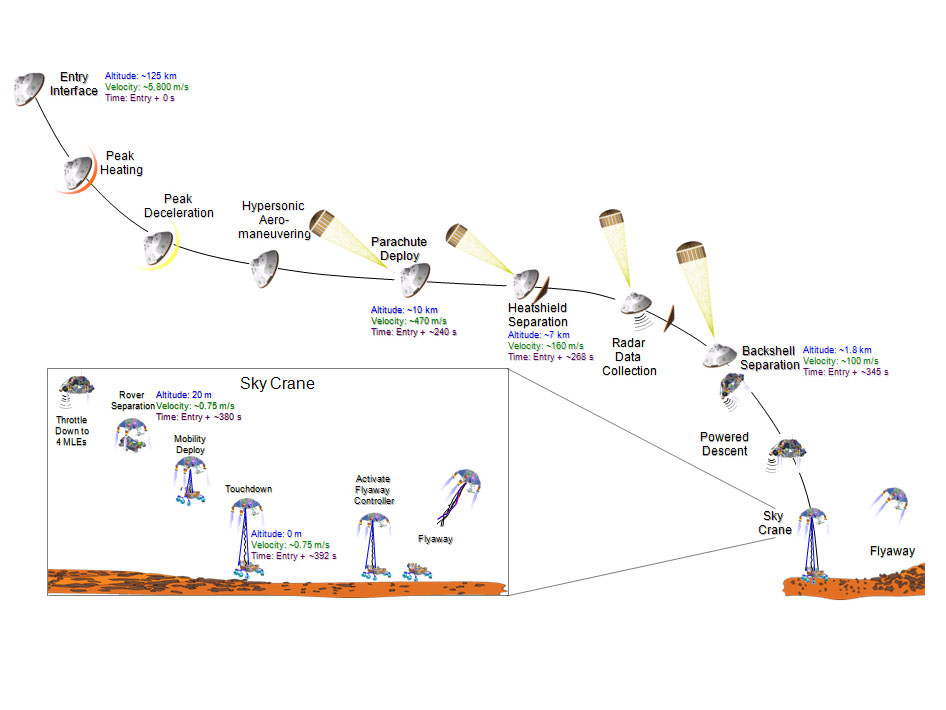
[/caption]
Now THIS is what I call “must-see TV!” A camera on the next Mars Rover — MSL, also known as Curiosity – will start recording high-definition video about two minutes before the rover lands on Mars, currently scheduled for August 2012. The Mars Descent Imager, or MARDI, will provide all of us Martian-wannabes with the first-ever ride along with the landing — and this will be a very unique landing, with the “Sky –Crane” lowering Curiosity to the planet’s surface. The video won’t be live, however – that’s way too much data for the spacecraft to send back to Earth at such an important event, but we will get to see it later. JPL provided a description of what the video should look like:
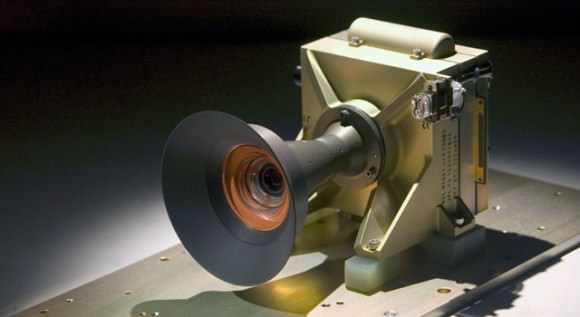
MARDI will start recording high-resolution video about two minutes before landing in August 2012. Initial frames will glimpse the heat shield falling away from beneath the rover, revealing a swath of Martian terrain below illuminated in afternoon sunlight. The first scenes will cover ground several kilometers (a few miles) across. Successive images will close in and cover a smaller area each second.
The full-color video will likely spin, then shake, as the Mars Science Laboratory mission’s parachute, then its rocket-powered backpack, slow the rover’s descent. The left-front wheel will pop into view when Curiosity extends its mobility and landing gear.
The spacecraft’s own shadow, unnoticeable at first, will grow in size and slide westward across the ground. The shadow and rover will meet at a place that, in the final moments, becomes the only patch of ground visible, about the size of a bath towel and underneath the rover.
Dust kicked up by the rocket engines during landing may swirl as the video ends and Curiosity’s surface mission can begin.
All of this, recorded at about four frames per second and close to 1,600 by 1,200 pixels per frame, will be stored safely into the Mars Descent Imager’s own flash memory during the landing. But the camera’s principal investigator, Michael Malin of Malin Space Science Systems, San Diego, and everyone else will need to be patient. Curiosity will be about 250 million kilometers (about 150 million miles) from Earth at that point. It will send images and other data to Earth via relay by one or two Mars orbiters, so the daily data volume will be limited by the amount of time the orbiters are overhead each day.
“We will get it down in stages,” said Malin. “First we’ll have thumbnails of the descent images, with only a few frames at full scale.”
Subsequent downlinks will deliver additional frames, selected based on what the thumbnail versions show. The early images will begin to fulfill this instrument’s scientific functions. “I am really looking forward to seeing this movie. We have been preparing for it a long time,” Malin said. The lower-resolution version from thumbnail images will be comparable to a YouTube video in image quality. The high-definition version will not be available until the full set of images can be transmitted to Earth, which could take weeks, or even months, sharing priority with data from other instruments.”
Wind Gust Gives Opportunity Rover a Power Boost
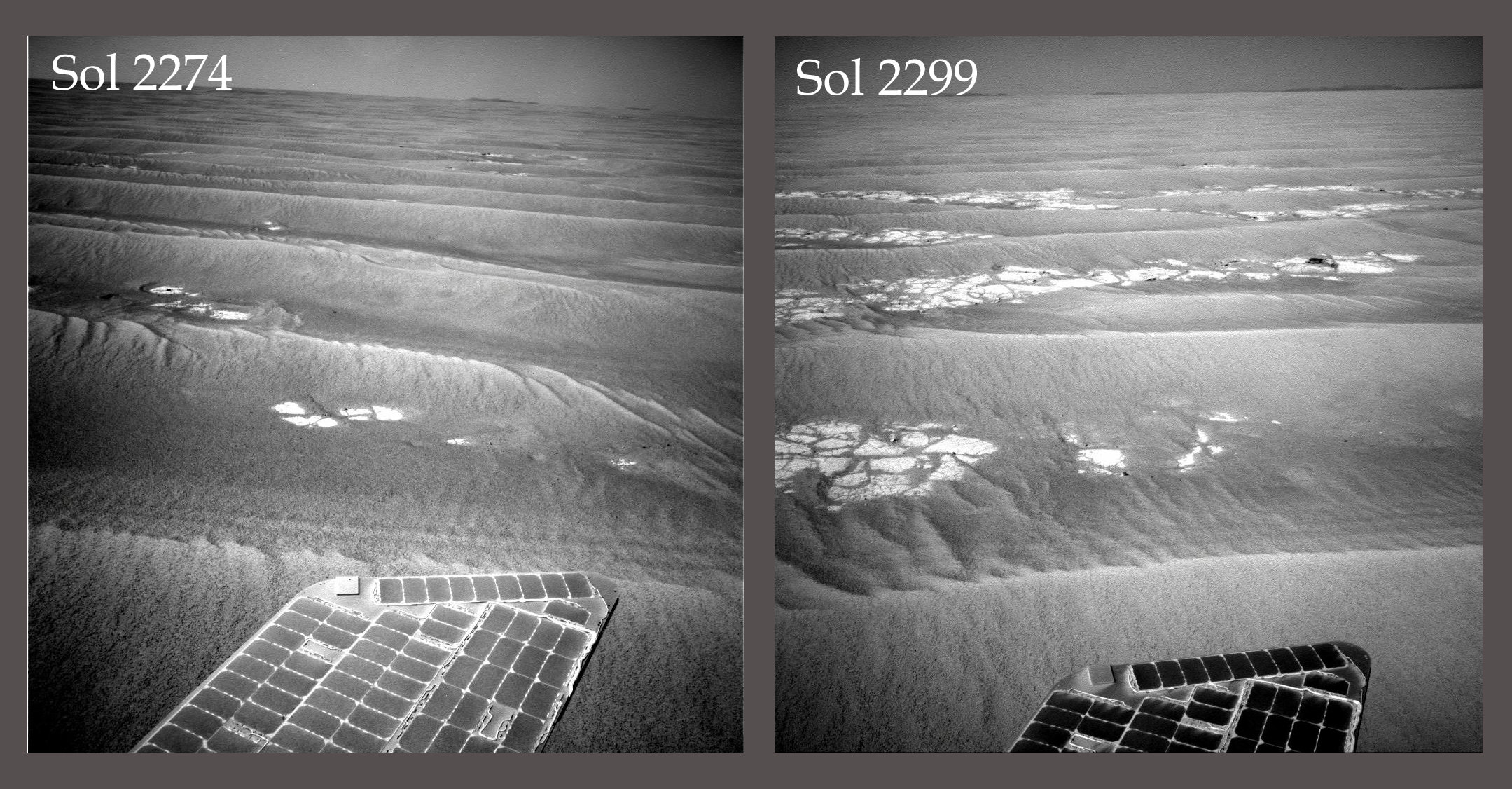
[/caption]
Either some little Martians came by and gave the Opportunity rover a quick once-over cleaning, or a recent gust of wind blew layers of dust off her solar panels. The image above (supplied by our favorite photo- whiz Stu Atkinson), shows Oppy’s solar panels on sol 2274 and 2299 (approximately June 18 and July 12 here on Earth) with a marked difference in the amount of dust on the panels. Yesterday, the Twitter account for the rovers, @marsrovers Tweeted: “Love those Martian dust busters! A recent wind gust cleaned Oppy’s solar panels giving her a little power boost for the road.” And on the road she is, heading earnestly for Endeavour Crater, with several recent drives of around 70 meters (230 feet) per sol. But she now has some new autonomous software the rover team is trying out, and with her new greater power capacity, she should be able to keep on truckin’. Mars rover driver Scott Maxwell reported on Twitter this week that Opportunity is 40% of the way from Victoria Crater to Endeavour.
And what’s the latest news about Spirit – still silent?
According to Maxwell (again on Twitter), the power models for sunlight hitting Gusev Crater say the very earliest we could possibly hear from Spirit could be sometime late this week. But he added that more likely would be hearing from Spirit by around mid-November.
But catching Spirit awake is complicated, with timing being everything. “Even if Spirit’s waking up (soon), we’ll have a hard time catching her during one of her wakeups,” Maxwell said. “This will take some luck as well as skill,” having the Mars Reconnaissance Orbiter or Mars Odyssey overhead and listening at the very moment Spirit is talking. Maxwell added that the team is working on how to locate Spirit if she’s had a Mission Clock fault and doesn’t know how to send communications to Earth.
It is very likely that Spirit has experienced a low-power fault and has turned off all sub-systems, including communication and gone into a deep sleep. While sleeping, the rover will use the available solar array energy to recharge her batteries. When the batteries recover to a sufficient state of charge, and if the Mission Clock hasn’t gone completely bonkers, Spirit will wake up and begin to communicate.
Spirit’s odometry remains at 7,730.50 meters (4.80 miles).
But meanwhile, Oppy’s total odometry is 21,550.77 meters (21.55 kilometers, or 13.99 miles), and she’ll be putting on more as she heads towards Endeavour Crater. Maxwell later said he has an idea to speed up the rover’s drives as much as 30%, so that will be interesting to find out more about his idea. “A 30% speedup would shave 2-3 months off our trip to Endeavour — maybe even more than that. Worth a try! Phyllosilicates, here we come!,” he tweeted, referring to the water-based minerals that scientists are hoping to find within the crater. That would mean water helped form the rocks in Mars’ early history.
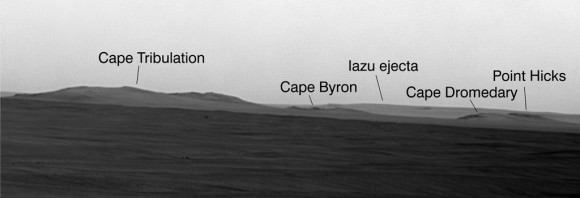
Speaking of Endeavour, recently, NASA and JPL released an image showing the newly-given names of different points on Oppy’s next destination, and there’s a push by some people in Australia for one additional feature to be named “Nobby’s Head.”
The rover team is using the theme of names of places visited by British Royal Navy Capt. James Cook in his 1769-1771 Pacific voyage in command of H.M.S. Endeavour. My friend Col Maybury from radio station 2NUR in Newcastle, New South Wales, Australia is helping to promulgate this request to NASA, with the support of the Minister of Tourism and Newcastle’s Lord Mayor. “Hopefully we will get a favourable reply soon,” Col wrote me.
Cook first came to this location in May of 1770. At midnight by moonlight he saw an island jutting up from the sea and wrote in his journal: “A small round rock or Island, laying close under the land, bore South 82 degrees West, distance 3 or 4 Leagues.”
Now called Nobby Head, it is the entrance of Newcastle Harbour, formed by the Hunter River, a great coal port of New South Wales. The feature on Mars is the same shape as Nobby Head on Earth. Wish Col and the people of Newcastle good luck in their “endeavour” to name this feature! (Anyone from the rover team naming committee reading this?!)
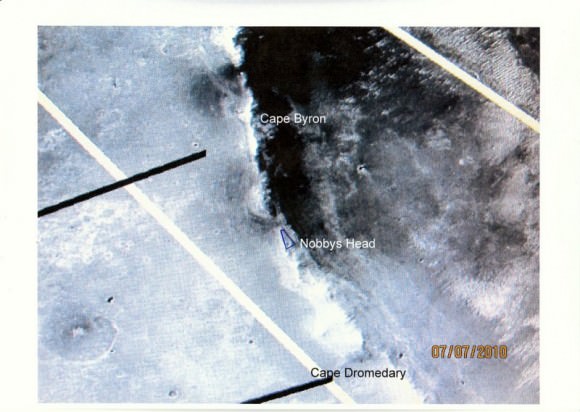
And don’t forget, Friday July 16 is Mars Day! The National Air and Space Museum has some ideas on how to celebrate.
Curiosity Gets Her Wheels
She’s a rover with places to go and things to do, so one of the main components of NASA’s next Mars rover, the Mars Science Lab (named Curiosity) is wheels. Last week, the wheels and a suspension system were installed on the rover, an important step in getting ready for her mission to Mars. Launch is currently scheduled for sometime between November 25 and Decemeber 18, 2011, and Curiosity’s mission is to study its landing site for habitable environments – both ancient and current.
Continue reading “Curiosity Gets Her Wheels”
Opportunity Rover Able to See More Detail of Endeavour Crater

[/caption]
Mars rover team members have begun informally naming features around the rim of Endeavour Crater, as they develop plans to investigate that destination when NASA’s Opportunity rover arrives there after many more months of driving. A new, super-resolution view of a portion of Endeavour’s rim reveals details that were not discernible in earlier images from the rover. Several high points along the rim can be correlated with points discernible from orbit.
Super-resolution is an imaging technique combining information from multiple pictures of the same target to generate an image with a higher resolution than any of the individual images.
Endeavour has been the team’s long-term destination for Opportunity since the summer of 2008, when the rover finished two years of studying Victoria Crater. By the spring of 2010, Opportunity had covered more than a third of the charted, 19-kilometer (12-mile) route from Victoria to Endeavour and reached an area with a gradual, southward slope offering a view of Endeavour’s elevated rim.
After the rover team chose Endeavour as a long-term destination, the goal became even more alluring when observations with the Compact Reconnaissance Imaging Spectrometer for Mars, on NASA’s Mars Reconnaissance Orbiter, found clay minerals exposed at Endeavour. Clay minerals, which form under wet conditions, have been found extensively on Mars from orbit, but have not been examined on the surface. Additional observations with that spectrometer are helping the rover team choose which part of Endeavour’s rim to visit first with Opportunity.
The team is using the theme of names of places visited by British Royal Navy Capt. James Cook in his 1769-1771 Pacific voyage in command of H.M.S. Endeavour for informal names of sites at Endeavour Crater. Points visible in the super-resolution view from May 12 include “Cape Tribulation” and “Cape Dromedary.”
See more images and info on the names of the different features at Stu Atkinson’s “Road to Endeavour” blog.
Evidence for Past Water on Mars Keeps Flowing, This Time from Glaciers

[/caption]
No sooner do we post one article about water on Mars when it’s time for another. Planetary scientists have uncovered telltale signs of water on Mars — frozen and liquid — in the earliest period of the Red Planet’s history. They found evidence of running water that sprang from glaciers throughout the Martian middle latitudes as recently as the Amazonian epoch, several hundred million years ago. These glaciofluvial valleys were, in essence, tributaries of water created when enough sunlight reached the glaciers to melt a thin layer on the surface. This led to “limited surface melting” that formed channels that ran for several kilometers and could be more than 150 feet wide.
The finding is “more than ‘Yes, we found water,’” said Caleb Fassett from Brown University, who along with Brown research analyst James Dickson, professor James Head III, and geologists from Boston University and Portland State University published a paper in Icarus. “What we see now is there’s this complex history of different environments where water is being formed.”
The team analyzed 15,000 images snapped by the Context Camera (CTX) aboard the Mars Reconnaissance Orbiter to compile the first survey of glaciofluvial valleys on Mars. The survey was sparked by a glaciofluvial valley that Dickson, Fassett, and Head spotted within the Lyot crater, located in the planet’s middle latitudes. The team, in a paper last year in Geophysical Research Letters, dated that meltwater-inspired feature to the Amazonian.
In his survey, Fassett found dozens of other Amazonian-era ice deposits that spawned supraglacial and proglacial valleys, most of them located on the interior and exterior of craters in Mars’ midlatitude belt. “The youthfulness (of the features) is surprising,” he said. “We think of [post-Noachian] Mars as really, really cold and really, really dry, so the fact that these exist, in those kinds of conditions, is changing how we view the history of water on the planet.”
What makes the finding even more intriguing is that the Brown planetary scientists can study what they believe are similar conditions on Earth. Teams from Brown and Boston University have visited the Antarctic Dry Valleys for years, where the surfaces of glaciers melt during the austral summer, sparking enough meltwater to carve a channel. The team will return to the Dry Valleys later this year to continue the study of this microclimate.
“It’s sort of crazy,” said Dickson, a member of the Brown team who stayed in the Dry Valleys for three months last year. “You’re freezing cold and there’s glacial ice everywhere, and it gets just warm enough that you get a river.”
Fassett plans to search for more glaciofluvial valleys as more images come from the CTX, which has mapped roughly 40 percent of the planet.
Source: Brown University
Water Was Widespread Across Early Mars, But No Oceans
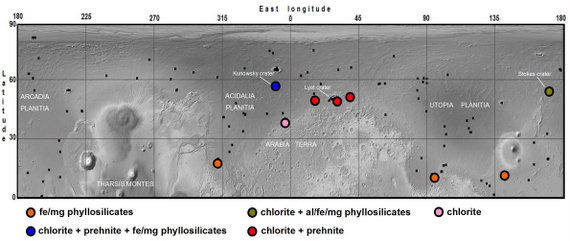
By looking at the mineralogy deep inside craters on Mars’ northern plains and comparing it to the makeup of regions in the southern hemisphere, scientists have found that widespread liquid water likely altered the majority of Red Planet’s crust about 4 billion years ago. However, the new findings do not support other recent studies that suggest a giant ocean covered Mars’ northern highlands.
Using the Mars Express OMEGA instrument and the Mars Reconnaissance Orbiter’s CRISM instrument, John Carter from Bibring at Université Paris in Orsay, France along with a group of scientists from France and the US, investigated large craters and found minerals which could have only formed in the presence of water. “We’ve detected hydrated minerals in about 10 of these craters,” Carter told Universe Today, “and we conclude that the ancient crust was altered in a similar way both in the south and in the north, in a very early environment which was much warmer and wetter than today’s.”
Carter added that in terms of Mars’ water history, this means liquid water existed near and on the surface of early Mars on a planetary scale, and is not restricted to select areas of the southern highlands.
Mars has dichotomy between north and south, (read our earlier article “The Two Faces of Mars Explained) so while the south is ancient, heavily cratered and high up, the north is smooth, with low-lying plains. It also is much younger and less cratered than the south. This is due to a volcanic mantling processes which filled up part of the lowlands and thus erased any former structures.
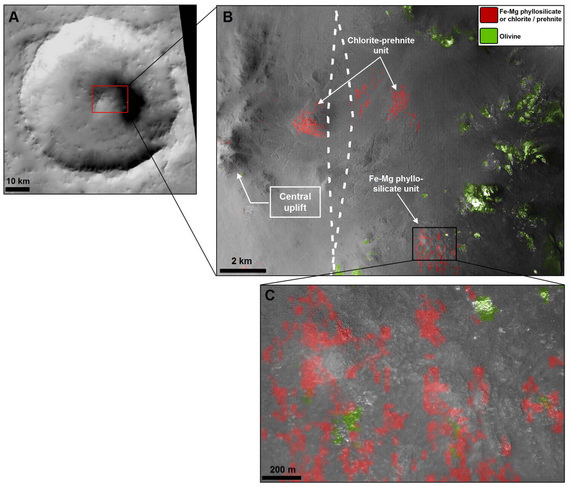
Carter and his team began their work based on studies of hundreds of sites in the southern hemisphere of Mars which were found to have hydrated minerals which formed on or near the surface some 4 billion ago in a wet and warm environment. While today Mars does not and cannot sustain liquid water on its surface, the scientists knew that a rather weak hydrological system had existed in the southern hemisphere, based on previous geological and morphological evidence.
If minerals in Mars’ northern hemisphere had formed in the presence of water, those minerals would have been buried by the widespread and intense lava flow which happened about 3 billion years ago, resurfacing that region of the planet. But looking into impact craters provides a window into Mars’ past by penetrating down through the lava flow, as well as showering chunks of the underlying crust across the nearby surface.
Carter said the data from OMEGA and CRISM show the mineral assemblages within and around these craters in the north as are very similar to what is seen in the southern ancient highlands, which includes phyllosilicates or other hydrated silicates.
“Our work broadens our view of liquid water on ancient Mars,” Carter said in an email, “spreading it to most of the planet, and may also provide a constraint on the timing of the northern hemisphere alteration with respect to its formation.”
Another conclusion, Carter said, is that these detections may be a constraint on when Mars could have possibly been conducive to the formation of life. “The main scenario which explains the dichotomy is that of an oblique impact between Mars and a fair sized celestial body, thus obliterating and re-melting a great deal of the northern hemisphere of Mars. Such an impact would surely have destroyed any pre-existing hydrated minerals at the depths at which we’re seeing them or we think they come from. Thus the water stability era likely took place after this giant impact, and did not last long (several hundred million years at most). Thus our work may provide a lower limit on this era.”
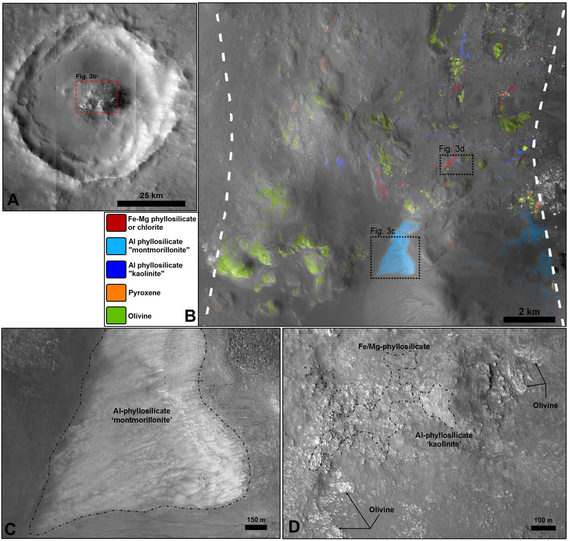
Concerning the giant ocean scenario for the northern highlands, on which a paper was published just last week, Carter said his team’s findings show evidence against those circumstances. “Previous work by a number of teams have actually shown the unlikelihood of a giant northern ocean on Mars younger than 3 billion years as hypothesized by several researchers,” he said. “There is no morphological nor mineralogical evidence for such an ocean. In our 10 or so craters of the northern plains of Mars where we found hydrated minerals, we also found mafic minerals such as olivine. This olivine is almost ubiquitous in northern plain craters, and the vast majority of it is unaltered. Olivine is very readily altered by liquid water hence a giant ocean which would have submerged all these craters should have altered all the olivine, and this is seldom the case.”
Carter said that studying craters from orbit provides a bit of a challenge. “It is hard, for example, to distinguish rocks from orbit which may have been excavated by the impact or actually formed after the impact when the heat released and the existing water and/or ice interacted with the rock to form new minerals, creating hydrothermal environments. In our paper we put forward several reasons why an excavation scenario is favored to a post-impact hydrothermal scenario.”
But craters on Mars provide a better study of the past than craters on Earth, since craters may exist on Mars for billions of year without much degradation, while on Earth water, tectonics and plant growth all conspire to conceal and change craters. Carter said the excavated material on Mars will not be altered by the current ultra-dry, cool environment on the Red Planet.
This research new appears in the June 25, 2010 issue of Science.
Sources: AAAS/Science, email exchange with John Carter
Best Class Project Ever: 7th Graders Find a Cave on Mars

[/caption]
Tip number one on “How to impress your classmates:” Find a mysterious cave on Mars. A group of 16 seventh-graders at Evergreen Middle School in Cottonwood, California, USA found a dark pit that appears to be an opening to a cave on Mars. Dennis Mitchell’s science class were examining Martian lava tubes as their project in the Mars Student Imaging Program offered by NASA and Arizona State University, which takes advantage of the huge database of images taken by the Mars Odyssey spacecraft. The students found the skylight pit on the slope of an equatorial volcano named Pavonis Mons, and it appears to be an entrance to an underground lava tube. Similar ‘cave skylight’ features have been found elsewhere on Mars, but this is the first seen on this volcano.
“The students developed a research project focused on finding the most common locations of lava tubes on Mars,” Mitchell said. “Do they occur most often near the summit of a volcano, on its flanks or the plains surrounding it?”
Mitchell said he and his students have been surprised how much interest there has been nation-wide in their discovery. “They were kind of shocked about the interest, and I think that they are just now starting to realize that they made a pretty neat discovery.”
The imaging program allows students in upper elementary grades through to college to participate in Mars research by having them develop a geological question to answer, and then directing the teams for the Mars-orbiting camera to take an image to answer their question. Since MSIP began in 2004, more than 50,000 students have participated.
Now, because of this find, the HiRISE high resolution camera on the Mars Reconnaissance Orbiter will take follow-up images of the pit to provide a better look at the object. HiRISE can image the surface at about 30 centimeters (12 inches) per pixel, which may allow a look inside the hole in the ground. This is part of the HiWISH program, where the public can submit suggestions to the science team for locations on Mars to the camera to image.
“It gives the students a good understanding of the way research is conducted and how that research can be important for the scientific community. This has been a wonderful experience,” Mitchell said.”
“Yeah it was a lot of fun because it wasn’t like any other science that we did, because we actually got to interact with real scientists instead of just people out of the book and stuff,” said 13-year-old Kody Rulofson, one of the students in Mitchell’s class.
Kody’s mother, Doni Rulofson said Kody and his twin brother Chase, also in the class, are inspired by the experience they had finding the cave. “They’re excited. They’re just beyond belief, they’re like, ‘we knew it was something really cool but we had no idea it was this much of an interest to NASA.'”
Odyssey has been orbiting the Red Planet since 2001, returning data and images of the Martian surface and providing relay communications service for Mars Rovers Spirit and Opportunity. Find out more about Odyssey here.
MRO has been in orbit since 2006, and has also amassed a huge database of images, which can be seen here.
Source: NASA
Video Tour of the Mars500 Habitat
Mars500 participant Diego Urbina (follow him on Twitter at @diegou) provides a tour inside the Mars500 facilities – see how the crew are living and working for the next 17 months in isolation. On June 3, 2010 Urbina and five fellow crewmates from Europe, Russia and China embarked on a 520-day mock mission to Mars, and are living in a crew module in a warehouse in Moscow. See our preview article here.
Vast Oceans Likely Covered One Third of Mars

[/caption]
Like rising waters from a flood, the evidence for past water on Mars — and large amounts of it – keep mounting. The latest study, which combined the analysis of water-related features including scores of delta deposits and thousands of river valleys with a look at the possibility of a global hydrosphere on early Mars, found that a vast ocean likely covered one-third of the surface of Mars some 3.5 billion years ago.
“Collectively, these results support the existing theories regarding the extent and formation time of an ancient ocean on Mars,” said Gaetano Di Achille and Brian Hynek from the Univesity of Colorado at Boulder, in their article in Nature Geoscience, “and imply the surface conditions during the time probably allowed the occurrence of a global and active hydrosphere integrating valley networks, deltas and a vast ocean as major components of an Earth-like hydrologic cycle.”
The idea of an ocean on Mars has been repeatedly proposed and challenged over the past two decades, and just last week, another study proposed lakes in the Hellas Basin region on Mars. This new study provides further support for the idea of a sustained sea on the Red Planet during the Noachian era more than 3 billion years ago.
More than half of the 52 river delta deposits identified by the CU researchers — each of which was fed by numerous river valleys — likely marked the boundaries of the proposed ocean, since all were at about the same elevation. Twenty-nine of the 52 deltas were connected either to the ancient Mars ocean or to the groundwater table of the ocean and to several large, adjacent lakes, Di Achille said.
The study is the first to integrate multiple data sets of deltas, valley networks and topography from a cadre of NASA and European Space Agency orbiting missions of Mars dating back to 2001, said Hynek. The study implies that ancient Mars probably had an Earth-like global hydrological cycle, including precipitation, runoff, cloud formation, and ice and groundwater accumulation.
Di Achille and Hynek used a geographic information system, or GIS, to map the Martian terrain and conclude the ocean likely would have covered about 36 percent of the planet and contained about 30 million cubic miles, or 124 million cubic kilometers, of water. The amount of water in the ancient ocean would have formed the equivalent of a 1,800-foot, or 550-meter-deep layer of water spread out over the entire planet.
The volume of the ancient Mars ocean would have been about 10 times less than the current volume of Earth’s oceans, Hynek said. Mars is slightly more than half the size of Earth.
The average elevation of the deltas on the edges of the proposed ocean was remarkably consistent around the whole planet, said Di Achille. In addition, the large, ancient lakes upslope from the ancient Mars ocean likely formed inside impact craters and would have been filled by the transport of groundwater between the lakes and the ancient sea, according to the researchers.
A second study headed by Hynek and involving CU-Boulder researcher Michael Beach of LASP and CU-Boulder doctoral student Monica Hoke being published in the Journal of Geophysical Research–Planets — which is a publication of the American Geophysical Union — detected roughly 40,000 river valleys on Mars. That is about four times the number of river valleys that have previously been identified by scientists, said Hynek.
The river valleys were the source of the sediment that was carried downstream and dumped into the deltas adjacent to the proposed ocean, said Hynek. “The abundance of these river valleys required a significant amount of precipitation,” he said. “This effectively puts a nail in the coffin regarding the presence of past rainfall on Mars.” Hynek said an ocean was likely required for the sustained precipitation.
“One of the main questions we would like to answer is where all of the water on Mars went,” said Di Achille. He said future Mars missions — including NASA’s $485 million Mars Atmosphere and Volatile Evolution mission, or MAVEN, which is being led by CU-Boulder and is slated to launch in 2013 — should help to answer such questions and provide new insights into the history of Martian water.
The river deltas on Mars are of high interest to planetary scientists because deltas on Earth rapidly bury organic carbon and other biomarkers of life and are a prime target for future exploration. Most astrobiologists believe any present indications of life on Mars will be discovered in the form of subterranean microorganisms.
“On Earth, deltas and lakes are excellent collectors and preservers of signs of past life,” said Di Achille. “If life ever arose on Mars, deltas may be the key to unlocking Mars’ biological past.”
Hynek said long-lived oceans may have provided an environment for microbial life to take hold on Mars.
Source: CU-Boulder
